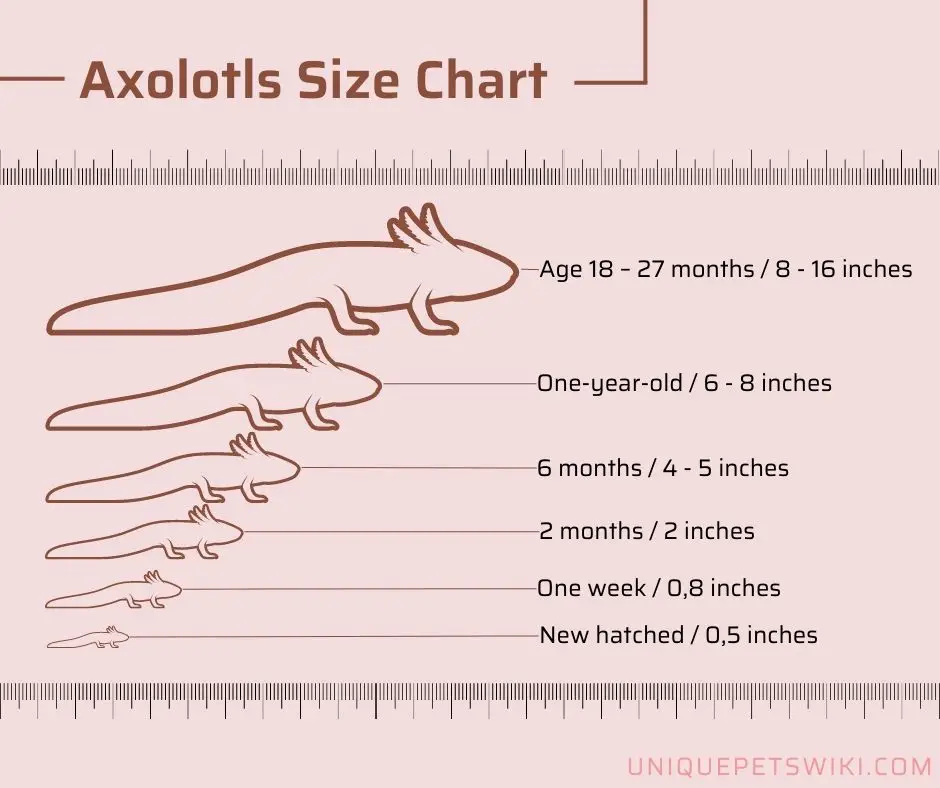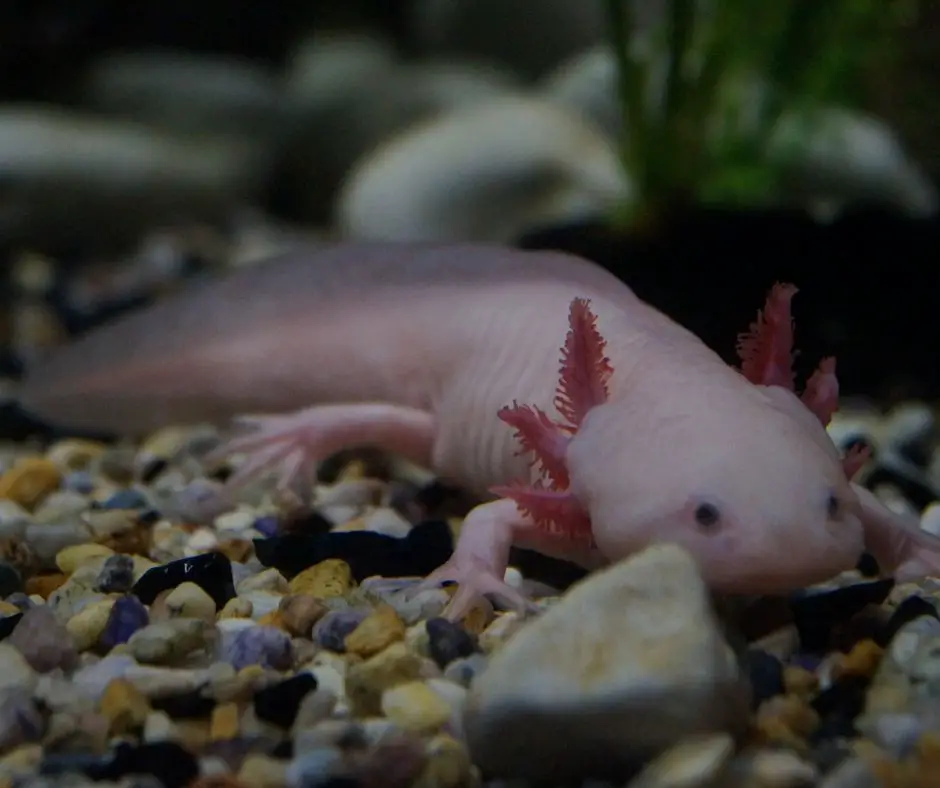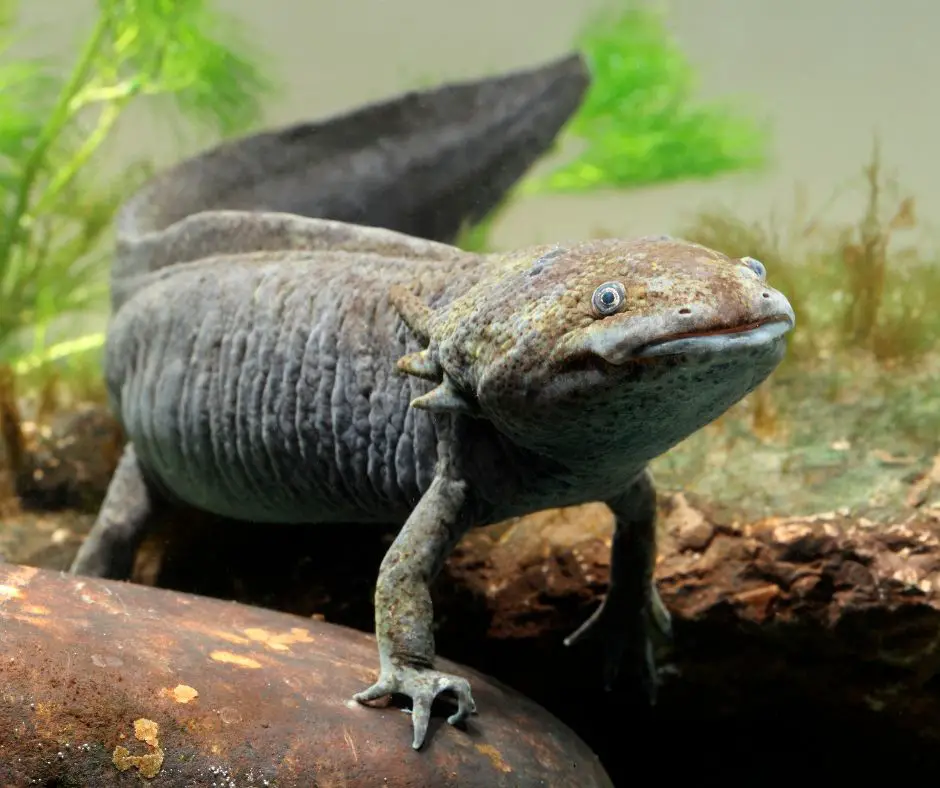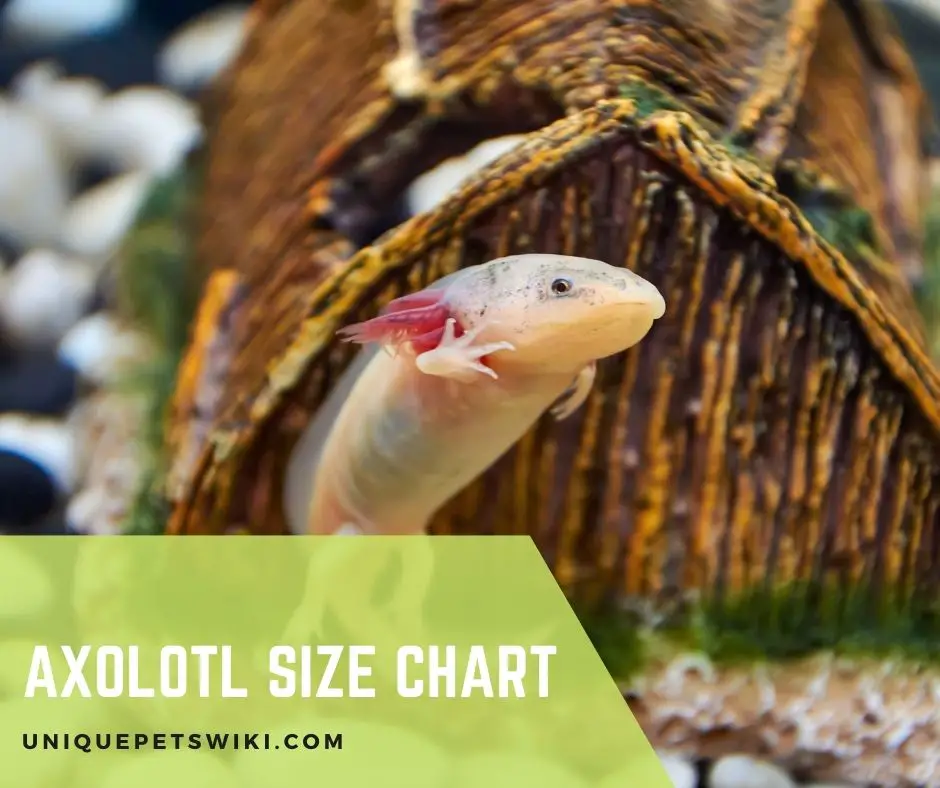Understanding what size your axolotl should be at can help you to monitor the size of your pet and know when something is wrong with its health – that is if it is stunted in growth or not.
Axolotls are not so big as adults. They are about the same size as juvenile catfish or slightly bigger.
From the nose to the tip of the tail, adult axolotls measure about 12 inches (30 cm) in length and weigh as much as 10.5 ounces (300 gr).
However, if well fed, adult axolotls can grow as long as 18 inches. On average, captive axolotls measure about 9 inches long.
Understanding the size your axolotl is present will help you know what best to feed it and what size of tank to house it. Especially, If you intend to keep more than one axolotl in the same tank.
That said, this article is going to walk you through the different sizes axolotls get at different stages/ages with axolotl size chart. Read on to learn more.
Contents
Axolotl Size Chart: How Big Do Axolotls Get?

Axolotls can reach 6 to 18 inches (15 – 45 centimeters) as adults. On average they measure between 9 and 10 inches and weigh about 10 ounces.
Interestingly, females can weigh up to 180 grams (20 inches), while males usually reach about 130 grams.
While axolotls will have different measurements at their various age, note that several factors could affect the growth rate of your axolotl.
These include poor feeding, poor husbandry, and inappropriate tank setup. Therefore, you must always maintain quality husbandry to ensure the growth of your pets.
To know how much your axolotl should measure/weigh at a given age, you can refer to the table below
Axolotls Size Chart
| Axolotl Age | Size |
| New hatched | 10 – 13 mm (roughly 0.5 inches). |
| One week | 2 cm |
| 2 months | 2 inches |
| 6 months | 4 – 5 inches |
| One-year-old | 6 – 8 inches |
| At age 18 – 27 months | 8 – 16 inches in length (15 – 45cm) |
Growth Rate of Axolotls
Depending on your husbandry, axolotls grow to full maturity within 6 months. With ideal husbandry, axolotl size development can be faster as well as it can be slower if kept under wrong tank conditions.
Axolotls have the fastest growth rate during their first 6 months up to 2 years of age. Within these ages, what you feed to your axolotl matters a lot because it can either enhance its growth or retard it.
For example, hatchlings and juvenile axolotls (between 3 – 5 months old) grew fastest on a diet of bloodworm and slowest on the Daphnia diet.
If you feed it a mixed diet (that is varieties of worms) it’ll result in intermediate/average growth rates.
In a nutshell, once your baby axolotls are born, they will grow fast to sexual or full maturity between 6 – 18 months.
Also read: Axolotl Eating Worm: Complete Guide
3 Factors Affecting Axolotl Size

While you want the best for your axolotl, understand that three things (genetics, habitat, and diet) can affect its growth rate – one of these factors which you do not have control over and the other two emanating from your husbandry.
Hence, the size of your pet axolotl depends on the quality of your husbandry which revolves around what you feed it, where it lives, and how it is kept.
Under different conditions, some can grow larger, while others will be smaller
- Genetics
Generally, it is believed that captive axolotls are usually smaller than wild ones. To some extent, this thought might be true and the main cause is genetics.
Example:
| Breeding axolotl (F1) | Male in the wild (12 inches) | Male in captivity (9 inches) |
| Female in the wild (12 inches) | Babies in the wild (about 12 inches) | Babies in captivity (9 – 12 inches) |
For instance, following the table, the resulting babies will inherit their parent’s genes. But over time babies in the wild become scarce. Baby axolotls in captivity will become the next breeding target.
The next time they breed, they will become purer and gradually lose the genetics of the first stage.
In a nutshell, genetics as a factor that affects axolotls’ size cannot be understood in isolation.
Therefore, to better understand why axolotls in captivity are often smaller than axolotls in the wild, let’s take a closer look at their habitat.
Aqueon 10 Gal Black Aquarium
- High quality glass construction with clean silicone sealed edges
- For freshwater and marine applications as well as desert or tropical terrarium applications
- Tank measures 20.25" long x 10.5" wide x 12.625" high
- Always include a drip loop when plugging aquarium appliances into the electrical outlet
- Place aquarium on a stand that is able to safely bear the weight of a filled aquarium
Last update on 2022-12-30 / Affiliate links / Images from Amazon Product Advertising API
- Habitat
When keeping axolotls as pets, what matters most aside from feeding is the environment they will live in – their tank setup.
Axolotls are solitary animals which means that they do not need to live in groups to thrive.
Hence, when kept with other animals (tank mates) or even other axolotls, there is always a clause “to be careful and watch out for cases of fights and injury”.
This may happen during feeding or when they are extremely hungry.
Interestingly, axolotls have the ability to regenerate genes and regrow some body parts that are lost without leaving any scar.
However, if this happens often because you crowded the tank with too many other animals, your axolotl will have to use most of its growing period to heal itself instead of growing bigger as it age.
Even if you house your axolotl in a small tank, it will not allow it enough space to move around freely as they do in the wild.
In a nutshell, the negative effect a small or crowded tank will have on your axolotls is that your axolotls will not have enough space to grow. Instead, they will adapt to the tank size.
So what then is the ideal tank size for one or two axolotls? An adult axolotl should be kept in at least a 20-gallon tank. Babies and juveniles can be kept in a 10-gallon tank.
If you plan to keep more than two axolotls or with tank mates, you should be thinking of getting a 55 or 75 gallons tank.
One other thing about axolotls’ ideal habitat is that they are cold-water animals. They require a water temperature of 59 – 65 degrees Fahrenheit (15°C – 18°C) in their tank to thrive.
Anything hotter or cooler than this can give them issues such as digestive problems.
Hence, when this ideal water temperature requirement isn’t met coupled with other water-quality issues, it can affect their growth rate and their size generally.
Water with excess ammonia will also prevent growth in pet axolotls.
- Diet
We have stated earlier how poor feeding can impact axolotls growth rate negatively. When it comes to feeding, what you feed babies and juveniles is different from what you feed adults.
The reason is that some food (worms) are too tough for the digestive system of young axolotls. Hence, why they need specific food at those ages.
The same thing as you cannot feed baby axolotl foods to adult axolotls as those kinds of foods will not have enough nutrients that are needed by adults.
For example, babies and juvenile axolotls need bloodworms and brine shrimps daily for growth.
But as adults, you should feed them earthworms, daphnia, and other worms and ensure that you feed them more live worms than frozen/thawed worms.
The list of what to feed and what not to feed your axolotl can be found in this article: What Can Axolotl Eat?
How Long Does It Take An Axolotl To Reach Full Size?

It takes about 6 – 18 months for hatchling axolotls to reach full maturity but it takes between 18 – 27 months for them to get to full size.
This means that even when they are adults, they still grow but at a very slow rate.
They grow fast during the first few months of their life and during this period they will need foods that can help them to grow.
When Do Axolotls Stop Growing?
Significant growth slows down once axolotls become sexually mature between 6 – 18 months. They stop growing once they reach 2 years and above.
How Do You Measure Axolotls?
To measure the full size/length of your axolotl, start from the nose (head) to the tip of the tail.
Take a piece of fishing line, and straighten it along your axolotl’s entire body starting from the nose down to the tip of the tail. Once you’re done take out the fishing line and measure it using a tape rule.
Do this while your pet is in the tank. You can also bring out your pet from the tank to take its measurement, but this will be stressful for the animal.
How Do You Know If An Axolotl Is Too Thin?
Have you ever wondered if axolotls can be thin – that is underweight? Yes, axolotls, if not properly cared for can be thin or underweight.
A healthy axolotl has an equal “head and body” proportion – that is the body is as big as the head and vis versa. But if the head is bigger than the body, the axolotl can be seen as underweight, thin, or unhealthy.
Is this something you should worry about? Yes, a thin-looking axolotl is a pointer that something is wrong with your husbandry.
This can be that your water parameters aren’t right, you’re feeding a poor or low in nutrients diet, your tank setup is poor, or that you aren’t offering a variety of foods.
If your axolotl is underfed and it’s something to be concerned about, how do you fatten it up?
- Offer it enough space by housing it in an appropriate size tank.
- Keep water parameters optimal. That is between 59 – 65 degrees Fahrenheit (15°C – 18°C).
- Offer only a good variety and high-quality foods.
- As they grow, ensure to separate baby axolotls by size from the bigger ones (adults).
Axolotl Getting Fat
If axolotls can get thin when underfed, they can get fat if overfed. The normal feeding schedule is daily feeding for babies and juveniles and 2 – 3 days a week for adults.
In one feeding, only feed them as many worms as they can eat. Avoid overfeeding as this can lead to overweight.
Also, one other thing that can make your axolotl fat is if you feed it foods that are high in fat than in protein.
Axolotls need high amounts of protein to grow and stay healthy. Therefore, foods (worms) that are rich in fat will make them fat.
What should do if your axolotl is already overweight? Check out our Axolotl feeding Guide for tips. In addition, do the following:
- Reduce the number of worms you’re feeding to your pet.
- Evaluate your husbandry and ensure that the environment encourages activity exercises.
- Reduce the number of days you’re currently feeding your pet.
- Offer varieties of food.
- Avoid foods that are rich in fat.
Python No Spill Clean and Fill Aquarium Maintenance System
- Will not disturb fish or decor during routine aquarium maintenance.
- Adapts easily to most faucets.
- Complete ready-to-use system.
Last update on 2022-12-29 / Affiliate links / Images from Amazon Product Advertising API
Conclusion
To be a good keeper, you must know what size your axolotl should measure at every given stage/age. This will help you to know when something is wrong and how best to address it.
Your axolotl’s size can give you insight into its feeding, water quality, and even your food quality.
If your axolotl is significantly losing or gaining weight, you can evaluate your husbandry to address where the issue is coming from.
But you can only know this if you have been measuring and keeping records of your pet’s size.


